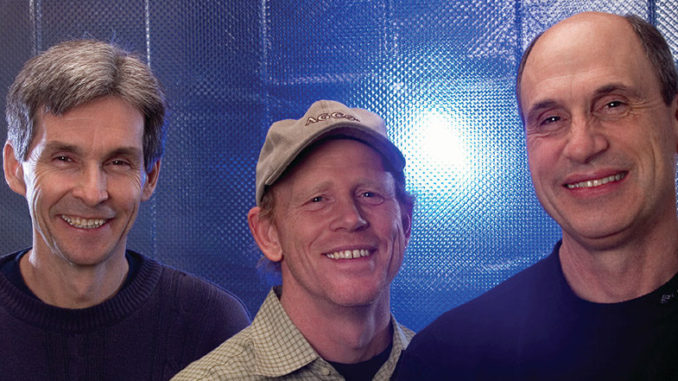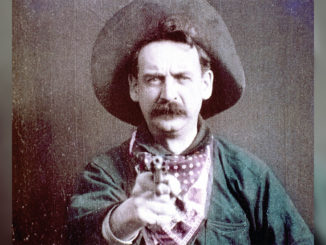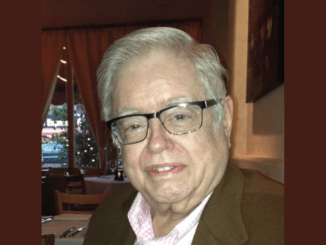
by Kevin Lewis
Editors Dan Hanley and Mike Hill, who won Academy Awards for film editing on Ron Howard’s Apollo 13 (1995), have known each other since the early 1970s when they were both working in the Paramount Studios shipping department. Hanley became friends with Robert James Kern, Jr., who was the editor on the sitcom Happy Days (on which Howard starred) at Paramount and the editor of Howard’s first directorial films. Kern’s father, Robert Kern, Sr., and his uncle, Hal C. Kern, both won Oscars for editing, Robert for National Velvet (1945) and Hal for Gone with the Wind (1939). Kern, Jr. became Hanley’s mentor in the business, training him as his assistant editor on those movies of the week. During Night Shift (1982), Kern was taken sick, Hanley took over as editor, and Howard asked him if he could recommend someone as his assistant. Hanley hired Hill, who also was an editor. They have worked together with Howard ever since.
“Seamless” is the term supervising sound editor Chic Ciccolini uses to describe the working method of Hanley and Hill, and indeed neither of the duo claims a specialty. They divide editing between them–one doesn’t do only action and the other only dialogue; they do each equally, on an “I’ll do this scene, you do that scene” basis. Then they work closely with Howard on re-editing the scenes. But, Hanley says, Howard believes in the collaboration process and trusts their initial decision-making.
As dialogue editor Branka Mrkic-Tana says, Hanley and Hill have worked so long with Howard that the editors are not only the eyes and ears of the director, but the emotions as well. And they are not protective of their skills, according to Ciccolini, who has been the sound editor with them since Gung Ho (1986). If Ciccolini needs an explanation for a picture editing decision to reconcile with his sound editing needs in a scene, Hill patiently goes through the film with him and reveals their step-by-step technique.
The first cut is accomplished roughly a week after Howard completes shooting scenes, a feat accomplished because of the editing tag-team.
Though Cinderella Man is a boxing movie, Hill appreciates its somber, character-driven quality, the despairing pauses in conversation and the refusal to push a scene by intercutting. A documentary quality infuses the film and its editing. “My thinking on editing always is not to try to push it,” he says. “Sometimes Ron might push us to do more, but I never like to make a cut unless there’s an absolute reason to make a cut, so this movie is perfect for that philosophy.
“It always felt right, the way the film was shot and the way the actors performed; it wasn’t difficult to make decisions,” Hill continues. “Everything felt right from the beginning. I didn’t feel that I had to labor over things very much; it was right there. There were a lot of takes in the boxing scenes, and that was the most difficult aspect of the movie from a technical standpoint.”
Hanley and Hill had to go through tons of footage from the six simultaneous cameras Howard used to shoot the fights. “Dan and I split up the different rounds and just worked on those. It was a relief to have some acting scenes come in for the next two days to give us a break.”
Howard shoots 35mm film, which is then digitalized for their editing on an Avid. Cutting on film and cutting on the Avid is like two different universes, say the editing duo. Gone are the days of “loading and unloading film and looking for the trims,” Hill says. “It is a much more civilized way to work. We don’t have all this film sitting around–on the walls, hanging in bins. It’s a nice clean environment. It frees you up to be more creative and not get bogged down in the physical part.” However, digital editing doesn’t shorten his workload because, “I can do so much more, I can experiment more, and not have to worry about cutting the print. Ron has us do multiple versions of some scenes, just because we can.”
The first cut is accomplished roughly a week after Howard completes shooting scenes, Hanley says, a feat accomplished because of the editing tag-team. Hanley was always comfortable with the dual editing system because of his working relationship as assistant to Kern, whom he calls “a true mentor,” and who let him cut as much as he wanted to. “If I wanted to come in on weekends and cut, if I wanted to cut at night…as long as I got the dailies ready for him,” says Hanley, Kern trusted and encouraged him.
“Seamless” is the term supervising sound editor Chic Ciccolini uses to describe the working method of Hanley and Hill.
Like Howard, Hanley was a recipient of the lessons learned in the old studio system because Kern’s family was an integral part of that vanished Hollywood, which Howard appreciated. “Both of us were cutting, and I think Ron may have liked that concept, to be able to bounce back and forth between two guys, two inputs,” Hanley adds.
When Hill joined Hanley during Night Shift, there was not a difference of opinion between them, Hanley insists. “We fell into a rhythm right from the get-go.” But there are still two minds. “Yeah, but in any given scene, or within scenes, there’s a certain way to cut it. Unless you’re doing something really artistically different, there’s a certain thing; you’re looking for the best performance, the best way to construct a scene, so I don’t think that really creates a problem, and it’s nice to bounce it off somebody else and pick his brain”–especially when there is an immense amount of footage. “Most good editors are going to cut the scenes pretty close to being the same,” says Hanley. “There might be little variables.”
The style of the film, Hanley believes, is worked out between the director and the cinematographer. He characterizes differences between editing teams as based on personality or dominance, or if the director plays one editor against the other and insecurities develop. “Ron creates an environment that I think is very productive creatively. Some people think the stress level drives more creativity. I like Ron’s approach. You feel free to go off in a direction and you’re not going to get hammered if you made the wrong choice,” says Hanley. According to Hill, “Ron doesn’t sit there with you in the editing room. I have never, ever had to deal with him sitting there when I’m cutting, and dictating anything. He’ll come in during shooting, usually on a Saturday, to look at scenes that we’ve cut, just to see how they’re working.”
They divide editing between them–one doesn’t do only action and the other only dialogue; they do each equally.
The two editors and Howard make decisions about shortening, deleting or changing scenes after they view the first cut of the movie, which usually runs around three and a half hours. Then they go through it, reel by reel, and immediately eliminate an hour’s running time. “Oftentimes some scenes will get juxtaposed, or a scene will be so drastically shortened or altered that it fits better in a different spot,” Hill says. “Then we start screening it with small audiences– people that we know, Ron‘s friends. Every time you look at it, you see things that pop out at you. Dan and I don’t worry too much about what scenes we’re going to eliminate in the early stages of cutting.”
Howard aids the editors by shooting a lot of coverage, and from multiple angles, so they always have a way out of an editing problem. “When you take out dialogue, you have something to cut to,” Hill explains. “When you don’t have a lot of coverage, sometimes you’re stuck.” The two editors do the temp mixes of music and sound effects before Ciccolini’s team commence the re-recording and final mix process.
Hanley likens editing a film to creating a painting. “You’re taking shots, and trying to construct them in a way that visually is stimulating. When you’re watching a film as an audience member, you’re taking in performance. When you’ve watched it several times, you start looking at the details, and say, ‘God, look at the extras, look at the production design, and the set…’”





